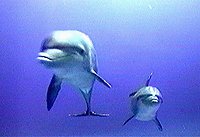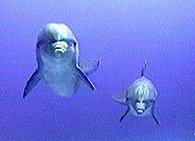Dolphin Research
 During
the Fiji winter of 1995, NAI'A took two months off from her normal
itinerary of dive charters to concentrate on a dolphin research project.
Prior to purchasing NAI'A, owner Rob Barrel studied behavioral anthropology
at Harvard University and at The University of California, Santa Cruz,
where his thesis dealt with the use of a passenger-carrying ship to
study the life-cycle of whales and dolphins in the wild. The 1995
research expeditions were his first chance to put the theory into
practice.
During
the Fiji winter of 1995, NAI'A took two months off from her normal
itinerary of dive charters to concentrate on a dolphin research project.
Prior to purchasing NAI'A, owner Rob Barrel studied behavioral anthropology
at Harvard University and at The University of California, Santa Cruz,
where his thesis dealt with the use of a passenger-carrying ship to
study the life-cycle of whales and dolphins in the wild. The 1995
research expeditions were his first chance to put the theory into
practice.
There are very few permanent schools of dolphins in Fiji. Besides this school, NAI'A has identified four other resident pods: one near Waya, one near Yasawa, one near Taveuni and another at our popular first-day dive site, Nukurauvula Passage. The reason there are so few dolphins here - and indeed throughout the small islands of the tropical Pacific - is because they require the proper combination of feeding and resting areas in close juxtaposition to one another. This means specifically that the spinner dolphins need a calm protected rest area that is immediately adjacent to a deep water food source. The ocean near Namotu Island is one of the only places in Fiji where this combination occurs.
 During
nearly two months with the Namotu dolphins, NAI'A was able to identify
several individuals by their unique markings, as well as establish
the pod's general pattern of behavior, confirming the observations
above. Probably more important was the dialog established between
NAI'A's researchers and the operators of small boats already working
in the area. Even after NAI'A returned to her bread-and-butter business
running dive charters, operators in the west continue to send in detailed
observations about the Namotu spinner dolphins so that the database
on them continues to grow.
During
nearly two months with the Namotu dolphins, NAI'A was able to identify
several individuals by their unique markings, as well as establish
the pod's general pattern of behavior, confirming the observations
above. Probably more important was the dialog established between
NAI'A's researchers and the operators of small boats already working
in the area. Even after NAI'A returned to her bread-and-butter business
running dive charters, operators in the west continue to send in detailed
observations about the Namotu spinner dolphins so that the database
on them continues to grow.
Unfortunately the Namotu spinner dolphins do not appear to be an appropriate subject for the continued long-term behavioral study for which NAI'A was designed. Spinner dolphins, in general, are somewhat antisocial, and the Namotu pod are no exception. Another problem for a long-term study is that the Namotu dolphins are already exploited by several day operators in the west, and their behavior is constrained by this activity. For these reasons, NAI'A has continued to survey Fiji waters to document the location and behavior of the various pods of dolphins.
